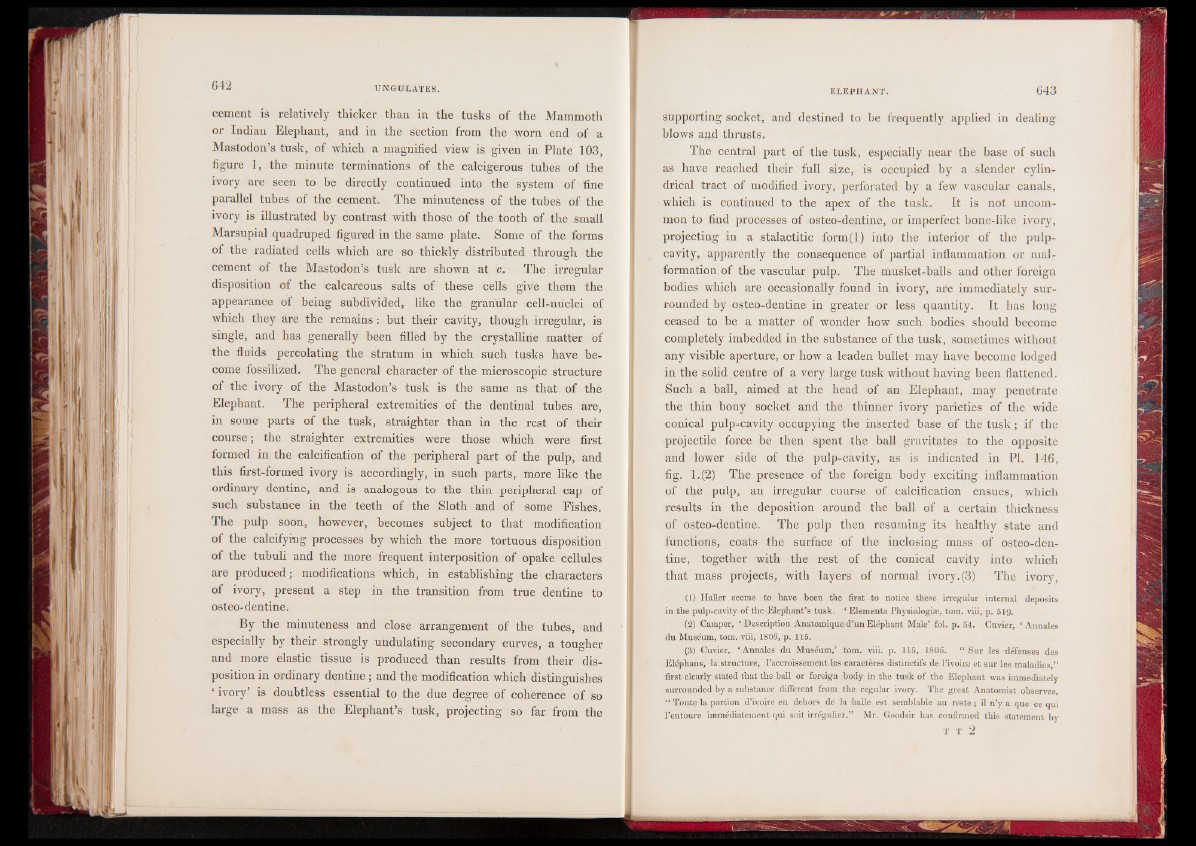
cement is relatively thicker than in the tusks of the Mammoth
or Indian Elephant, and in the section from the worn end of a
Mastodon’s tusk, of which a magnified view is given in Plate 103,
figure 1 , the minute terminations of the calcigerous tubes of the
ivory are seen to be directly continued into the system of fine
parallel tubes of the cement. The minuteness of the tubes of the
ivory is illustrated by contrast with those of the tooth of the small
Marsupial quadruped figured in the same plate. Some of the forms
of the radiated cells which are so thickly distributed through the
cement of the Mastodon’s tusk are shown at c. The irregular
disposition of the calcareous salts of these cells give them the
appearance of being subdivided, like the granular cell-nuclei of
which they are the remains : but their cavity, though irregular, is
single, and has generally been filled by the crystalline matter of
the fluids percolating the stratum in which such tusks have become
fossilized. The general character of the microscopic structure
of the ivory of the Mastodon’s tusk is the same as that of the
Elephant. The peripheral extremities of the dentinal tubes are,
in some parts of the tusk, straighter than in the rest of their
course ; the straighter extremities were those which were first
formed in the calcification of the peripheral part of the pulp, and
this first-formed ivory is accordingly, in such parts, more like the
ordinary dentine, and is analogous to the thin peripheral cap of
such substance in the teeth of the Sloth and of some Fishes.
The pulp soon, however, becomes subject to that modification
of the calcifying processes by which the more tortuous disposition
of the tubuli and the more frequent interposition of opake cellules
are produced; modifications which, in establishing the characters
of ivory, present a step in the transition from true dentine to
osteo-dentine.
By the minuteness and close arrangement of the tubes, and
especially by their strongly undulating secondary curves, a tougher
and more elastic tissue is produced than results from their disposition
in ordinary dentine ; and the modification which distinguishes
‘ ivory’ is doubtless essential to the due degree of coherence of so
large a mass as the Elephant’s tusk, projecting so far from the
supporting socket, and destined to be frequently applied in dealing
blows apd thrusts.
The central part of the tusk, especially near the base of such
as have reached their full size, is occupied by a slender cylindrical
tract of modified ivory, perforated by a few vascular canals,
which is continued to the apex of the tusk. It is not uncommon
to find processes of osteo-dentine, or imperfect bone-like ivory,
projecting in a stalactitic form(l) into the interior of the pulp-
cavity, apparently the consequence of partial inflammation or malformation
of the vascular pulp. The musket-balls and other foreign
bodies which are occasionally found in ivory, are immediately surrounded
by osteo-dentine in greater or less quantity. It has long
ceased to be a matter of wonder how such bodies should become
completely imbedded in the substance of the tusk, sometimes without
any visible aperture, or how a leaden bullet may have become lodged
in the solid centre of a very large tusk without having been flattened.
Such a hall, aimed at the head of an Elephant, may penetrate
the thin bony socket and the thinner ivory parieties of the wide
conical pulp-cavity occupying the inserted base of the tusk ; if the
projectile force be then spent the ball gravitates to the opposite
and lower side of the pulp-cavity, as is indicated in PL 146,
fig. 1.(2) The presence of the foreign body exciting inflammation
of the pulp, an irregular course of calcification ensues, which
results in the deposition around the ball of a certain thickness
of osteo-dentine. The pulp then resuming its healthy state and
functions, coats the surface of the inclosing mass of osteo-dentine,
together with the rest of the conical cavity into which
that mass projects, with layers of normal ivory. (3) The ivory,
" (1) Haller seems to have been the first to notice these irregular internal deposits
in the pulp-cavity of the Elephant’s tusk. ‘Elementa Physiologiæ, tom. viii, p. 519.
(2) Camper, ‘ Description Anatomique d’un Elephant Male’ fol. p. 54. Cuvier, ‘Annales
du Muséum, tom. viii, 1806, p. 115.
(3) Cuvier, ‘Annales du Muséum,’ tom. viii. p. 115, 1806. “ Sur les-défenses des
Eléphans, la structure, l’accroissement les caractères distinctifs de l’ivoire et sur les maladies,”
first clearly stated that the ball or foreign body in the tusk of the Elephant was immediately
surrounded by a substance different from the regular ivory. The great Anatomist observes,
“ Toute la portion d’ivoire en dehors de la balle est semblable au reste; il n’y a que ce qui
l’entoure immédiatement qui soit irrégulier.” Mr. Goodsir has confirmed this statement by